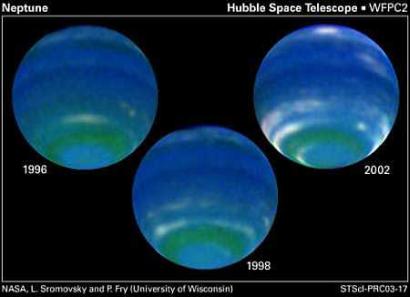Spring has arrived on Neptune, which promises 40 years of bright clouds - a surprise for astronomers who do not expect a change of seasons on a planet so far from the sun

Spring has arrived on Neptune, which promises 40 years of clear clouds - a surprise for astronomers who do not expect a change of seasons on a planet so far from the sun.
In fact, only the southern hemisphere experiences spring. This is according to observations made by the Hubble Space Telescope. Like Earth, Neptune has a tilted axis, meaning that when spring is in the south, autumn prevails in the north.
These observations, reported in the May issue of the panel scientific monthly Icarus, are surprising because so far no one has seen a change of seasons in Neptune, claims astronomer Lawrence Surombsky of the University of Wisconsin-Madison.
"Neptune has not yet externalized its seasons," Soromovsky told the AP news agency. "However, Hubble's observations from 1996 to 2002 show that the high cloud bands expanded and brightened." This is also consistent with ground-based observations that have shown this trend since 1980, Sromovsky says.
Neptune, the eighth planet from the sun is known to have strange weather anyway, with brutal storms with winds of 1,500 km/h. Its distance from the Sun is 30 times greater than Earth's, which means that sunlight is 900 times weaker on Neptune and therefore too weak to create seasonal changes.
Some astronomers have theorized that the brightening of the clouds on Neptune is a response to the sun's cycle - sunspots and other phenomena associated with our mother star, but the tests did not find such a match, Samorovsky says.
Another possible scenario is that, despite their low intensity, by the time the sun's rays reach Neptune, they are strong enough to create a change of seasons there.
Because of Neptune's distance, his year lasts 165 Earth years, and therefore each season lasts 40 years, and there are differences between the astronomical beginning of the season and its peak, as it happens on Earth.
For example, the hottest day of the year is rarely the day of the summer solstice, that is, the hottest day in Nash. Usually the hot period is a month or more later in the high latitudes. A similar thing is stirring in Neptune, but the differences sometimes reach thirty years. Samorowski said.
In any case, there is no point in trying to build a summer house on Neptune. The temperature as a whole at the height of summer may reach minus one hundred degrees Celsius and the winds are freezing.
At the equator there are no winds and you don't feel the changing of the seasons, not even the daily weather changes. At higher latitudes, Neptune provides some changes in cloud cover or eddies. In any case, it's also cold there all the time.
